Lecture 18: Robust nonlinear solvers#

The problem#
Given a continuous function \(f(x)\), the problem is to find a point \(x^*\) such that \(f(x^*) = 0\). That is, \(x^*\) is a solution of the equation \(f(x) = 0\) and is called a root of \(f(x)\).
Summary so far#
Bisection |
Newton’s method |
Modified Newton |
Secant |
|
|---|---|---|---|---|
Simple algorithm |
yes |
yes |
yes |
yes |
Starting values |
bracket |
one |
one |
two |
Iterations |
lots |
normally fewer |
similar to Newton |
similar to Newton |
Function evals |
one per iteration |
|
two per iteration |
one per iteration |
Convergence |
with good bracket |
not always |
not always |
not always |
Turing point roots |
no |
slower |
slower |
slower |
Use of derivative |
no |
yes |
no |
no |
The big idea#
Combine the robustness of the bisection but improve the estimate using the secant method.
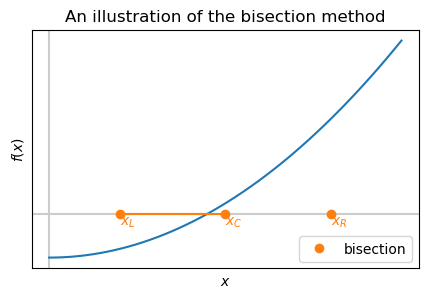
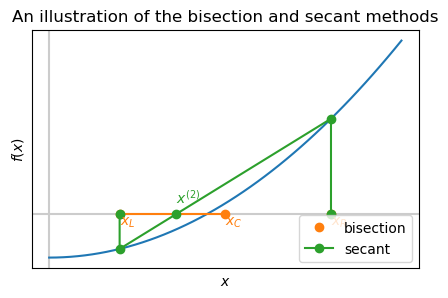
The bisection method doesn’t use the values of \(f\) only it’s sign. Use the values of \(f\) at the end points to improve the convergence rate.
False position method (regula falisi)#
The idea is to take the bisection method but instead of evaluating f and the midpoint of \((x_L, x_R)\) and computing signs, we evaluate at the point obtained from the application of the secant method to \(x_L, x_R\):
def false_position(func, a, b, tol=1.0e-10):
# Starting values
fa = func(a)
fb = func(b)
fc = tol + 1
while b - a > tol and abs(fc) > tol:
# Find new point **using secant method**
c = b - fb * (b - a) / (fb - fa)
fc = func(c)
# if root is in left half of interval
if fa * fc < 0.0:
# move right end
b = c
fb = fc
else:
# otherwise,
# move the left end
a = c
fa = fc
return c
Example#
A simply example \(f(x) = x^2 - 2\) starting from bracket \((1, 2)\).
What happens to the right end of the bracket?
def f(x):
return x * x - 2.0
false_position_with_table(f, 1.0, 2.0, tol=1.0e-4)
| it | a | f(a) | b | f(b) | c | f(c) |
|---|---|---|---|---|---|---|
| 0 | 1.000000 | -1.000000 | 2.000000 | 2.000000 | -- | -- |
| 1 | 1.333333 | -0.222222 | 2.000000 | 2.000000 | 1.333333 | -0.222222 |
| 2 | 1.400000 | -0.040000 | 2.000000 | 2.000000 | 1.400000 | -0.040000 |
| 3 | 1.411765 | -0.006920 | 2.000000 | 2.000000 | 1.411765 | -0.006920 |
| 4 | 1.413793 | -0.001189 | 2.000000 | 2.000000 | 1.413793 | -0.001189 |
| 5 | 1.414141 | -0.000204 | 2.000000 | 2.000000 | 1.414141 | -0.000204 |
| 6 | 1.414201 | -0.000035 | 2.000000 | 2.000000 | 1.414201 | -0.000035 |
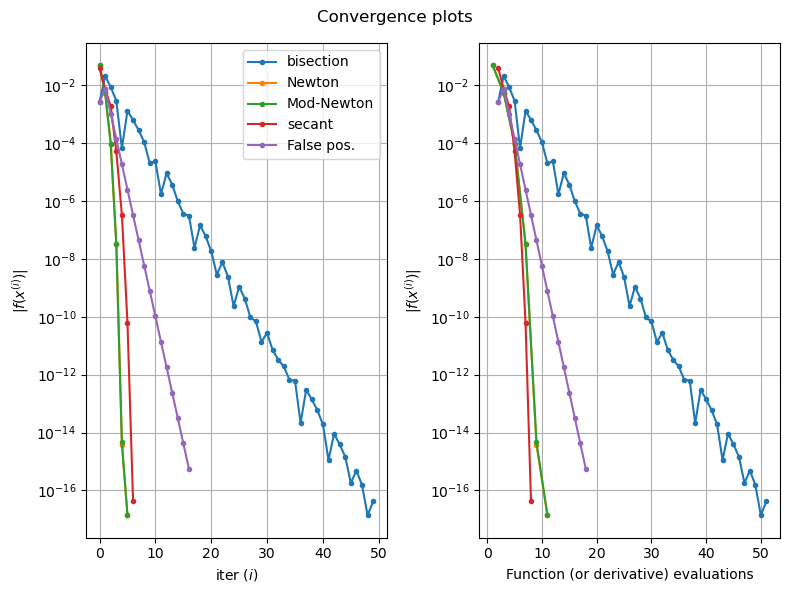
Dekker’s method#
This is a another hybrid method that combines the bisection and secant method.
We find two candidates for approximating the root - given by the secant method and by the bisection method. \(b\) becomes the new estimate of the root and \(a\) is updated to maintain the bracket.
The function requires both an initial bracket:
def dekker(func, a, b, tol=1.0e-10):
assert func(a) * func(b) < 0 # ensure we have a bracket
c = a # start old b at a
assert abs(b - c) > tol # ensure we have b != c
def dekker(func, a, b, tol=1.0e-10):
# start at old b at a
c = a
while abs(f(b)) > tol:
# generate two possible estimates
m = midpoint_update(func, a, b)
try:
s = secant_update(func, b, c)
except ZeroDivisionError:
s = m
# choose best b and update c
b, c = update_b(b, s, m), b
# choose a to form a bracket
a = update_a(func, a, b, c)
# choose best value for iteration from a and b
a, b = best_ab(func, a, b)
return b
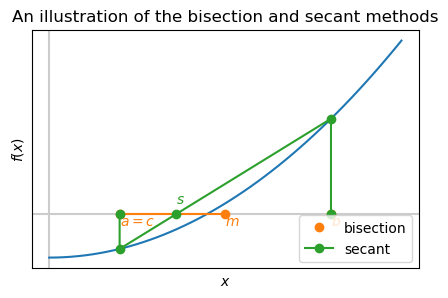
def secant_update(func, x, xn):
return x - func(x) * (x - xn) / (func(x) - func(xn))
def midpoint_update(func, xL, xR):
return (xL + xR) / 2

def update_b(b, s, m):
# if s lies strictly between m and b
if (m < s and s < b) or (b < s and s < m):
# b <- s (secant)
return s
else:
# b <- m (midpoint)
return m

def update_a(func, a, b, c):
# set a to be either a or c so that f(a)*f(b) < 0
if func(a) * func(b) < 0:
# (a, b) form a bracket: a <- a
return a
elif func(c) * func(b) < 0:
# (c, b) form a bracket: a <- c
return c
else:
raise Exception("No bracket found")
def best_ab(func, a, b):
# if a is better estimate
if abs(func(a)) < abs(func(b)):
# swap!
return b, a
else:
# don't swap!
return a, b
Examples#
A simply example \(f(x) = x^2 - 2\) starting from bracket \((1, 2)\)
What happens to the left end of the bracket?
def f(x):
return x * x - 2
dekker(f, a=1.0, b=2.0, tol=1.0e-4)
| it | a | f(a) | b | f(b) | update |
|---|---|---|---|---|---|
| 0 | 1.000000 | -1.000000 | 2.000000 | 2.000000 | None |
| 1 | 1.000000 | -1.000000 | 1.500000 | 0.250000 | midpoint |
| 2 | 1.000000 | -1.000000 | 1.428571 | 0.040816 | secant |
| 3 | 1.000000 | -1.000000 | 1.414634 | 0.001190 | secant |
| 4 | 1.000000 | -1.000000 | 1.414216 | 0.000006 | secant |
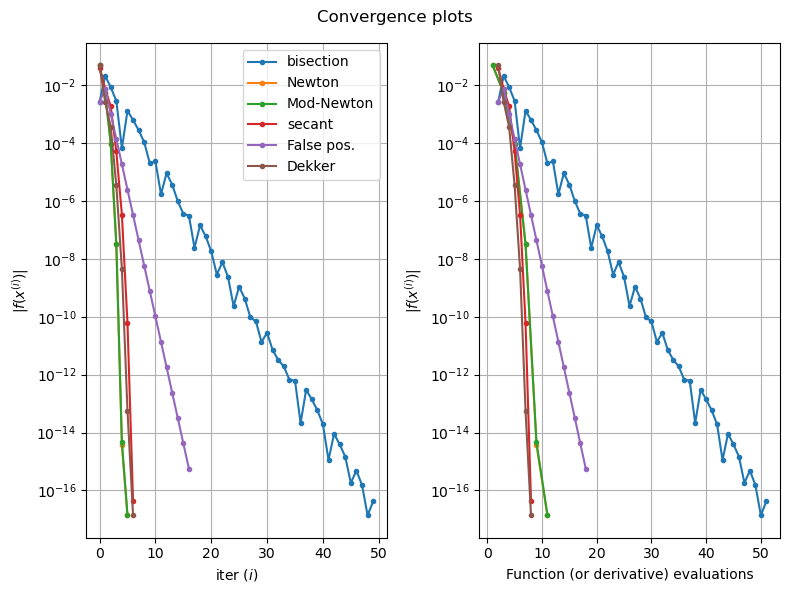
Summary#
Bisection |
Newton’s method |
Modified Newton |
Secant |
False position |
Dekker |
|
|---|---|---|---|---|---|---|
Simple algorithm |
yes |
yes |
yes |
yes |
yes |
more complicated |
Starting values |
bracket |
one |
one |
two |
bracket |
bracket |
Iterations |
lots |
normally fewer |
similar to Newton |
similar to Newton |
middle |
similar to Newton |
Function evals |
one per iteration |
|
two per iteration |
one per iteration |
one per iteration |
one per iteration |
Convergence |
with good bracket |
not always |
not always |
not always |
with good bracket |
with good bracket |
Turing point roots |
no |
slower |
slower |
slower |
no |
no |
Use of derivative |
no |
yes |
no |
no |
no |
no |

